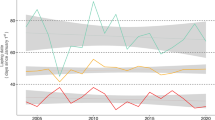Summary
Blackcaps (Sylvia atricapilla) that breed in central Europe have usually migrated to Mediterranean or African wintering grounds. In the past several decades, a portion of this breeding population has started migrating to the British Isles to overwinter and this population has increased dramatically. Several factors, including higher annual survivorship (due to supplemental feeding and reduced migratiry distance), assortative mating, and enhanced reproductive success may be involved in this rapid population growth. As part of an intensive, long-term study of this population, we tested the hypothesis that the differences in photoperiod experienced by British-wintering versus Mediterranean-wintering blackcaps might lead to relatively early vernal (i.e., migratory and/or reproductive) physiological condition in members of the former group. We found that birds exposed to photoperiodic conditions that simulated migration to Britain to overwinter generally initiated vernal migratory activity earlier than birds held under conditions simulating migration to traditional wintering areas in central Spain. This difference, coupled with the shorter migratory distance to the British Isles, leads to significantly earlier estimated arrival dates for blackcaps that winter in Britain compared to central Spain. Bimodality in arrival times suggests that assortative mating on central European breeding grounds might occur between members of the different wintering populations. Males exposed to British-winter photoperiods showed significantly earlier testicular development than males kept under Spanish-winter photoperiods. Early arrival on the breeding grounds, coupled with accelerated reproductive condition, should lead to a relatively early reproductive effort, perhaps increasing average reproductive success. In general, these results support the hypothesis that differences in photoperiod on the wintering grounds may play an important role in the dynamic state of this population.
Similar content being viewed by others
References
Berthold P (1969) Die Laparotomie bei Vögeln. Zool Gart 37:271–279
Berthold P (1988a) Evolutionary aspects of migratory behavior in European Warblers. J Evol Biol 1:195–209
Berthold P (1988b) The control of migration in European warblers. In: Ouellet H (ed) Acta XIX Congressus Ornithologici, vol 1. University of Ottawa Press, Ottawa, Canada, pp 213–249
Berthold P, Querner U (1981) Genetic basis of migratory behavior in European warblers. Science 212: 77–79
Berthold P, Schlenker R (1988) Sylvia atricapilla (Linnaeus 1758) — Mönchsgrasmücke. In: Glutz von Blotzheim U, Bauer K (eds) Handbuch der Vögel Mitteleuropas, Bd 11, Aula-Verlag, Wiesbaden (in press)
Berthold P, Terrill S (1988) Migratory behaviour and population growth of Blackcaps wintering in Britain and Ireland: some hypotheses. Ringing and Migration 9:153–159
Berthold P, Gwinner E, Klein H (1970) Vergleichende Untersuchung der Jungendentwicklung eines ausgeprägten Zugvogels, Sylvia borin, und eines weniger ausgeprägten Zugvogels, S. atricapilla. Vogelwarte 25:297–331
Berthold P, Querner U, Schlenker R (1990) Die Mönchgrasmücke. Die Neue Brehm-Bücherei, Ziemsen Verlag, Wittenberg Lutherstadt (in press)
Bland RL (1986) Blackcap. In: Lack P (ed) The Atlas of Wintering Birds in Birtain and Ireland. T and AD Poyser, Ltd., Calton, Great Britain, pp 332–333
Farner DS, Follet BK (1966) Light and other environmental factors affecting avian reproduction. J Anim Sci 25:90–118
Fouarge, J (1981) La Fauvette à Tête noire (Sylvia atricapilla). Exploitation des Données Belges de baguage. Le Gerfaut 71:677–716
Gauthreaux SA Jr (1982) The ecology and evolution of avian migration systems. In: Farner DS, King JR, Parkes KC (eds) Avian biology, vol 6. Academic Press, New York, pp 93–168
Gladwin T (1970) Wintering Blackcaps. BTO News 39:1–2
Gwinner E (1987) Annual rhythms of gonadal size, migratory disposition and molt in Garden Warblers, Sylvia borin exposed in winter to an equatorial or a southern hemisphere photoperiod. Ornis Scand 18:251–256
Ketterson ED, Nolan V Jr (1985) Intraspecific variation in avian migration: evolutionary and regulatory aspects. In: Rankin, MA (ed) Migration: mechanisms and adaptive significance. Contributions in Marine Science Suppl vol 27. University of Texas Marine Science Institute, Port Aransas, Texas, pp 553–579
Klein H, Berthold P, Gwinner E (1973) Der Zug europäischer Garten- und Mönchsgrasmücken (Sylvia borin und S. atricapilla). Vogelwarte 27:73–134
Langslow DR (1978) Recent increases of Blackcaps at bird observatories. Brit Birds 71:345–354
Langslow DR (1979) Movements of Blackcaps ringed in Britain and Ireland. Bird Study 26:239–252
Leach IH (1981) Wintering Blackcaps in Britain and Ireland. Bird Study 28:5–14
Nicholls TJ, Storey CR (1977) The effect of duration of the daily photoperiod on recovery of photosensitivity in photorefractory canaries (Serinus canarius). Gen comp Endocr 31:72–74
Nicholls TJ, Goldsmith AR, Dawson A (1988) Photorefractoriness in birds and comparison with mammals. Physiol Rev 68:133–176
Rice C (1970) Wintering Blackcaps in Wiltshire. Wilts Archeol Nat Hist Mag 65 (Part A): 12–15
Schwabl H (1983) Ausprägung und Bedeutung des Teilzugverhaltens einer südwestdeutschen Population der Amsel Turdus merula. J Orn 124:101–116
Simms E (1985) British warblers. Collins, London
Smith HG, Nilsson JA (1987) Intraspecific variation in migratory pattern of a partial migrant, the Blue Tit (Parus caeruleus): an evaluation of different hypotheses. Auk 104:109–115
Stafford J (1956) The wintering of Blackcaps in the British Isles. Bird Study 3:251–257
Terrill SB, Berthold P (1989) Experimental evidence for endogenously programmed differential migration in the blackcap (Sylvia atricapilla). Experientia 45:207–209
Williams TD, Dawson A, Nicholls TJ, Goldsmith AR (1987) Short days induce premature reproductive maturation in juvenile starlings, Sturnus vulgaris. J Reprod Fert 80:327–333
Zink G (1973) Der Zug europäischer Singvogel I. Vogelzug-Verlag. Moeggingen, West Germany
Author information
Authors and Affiliations
Rights and permissions
About this article
Cite this article
Terrill, S.B., Berthold, P. Ecophysiological aspects of rapid population growth in a novel migratory blackcap (Sylvia atricapilla) population: an experimental approach. Oecologia 85, 266–270 (1990). https://doi.org/10.1007/BF00319412
Received:
Accepted:
Issue Date:
DOI: https://doi.org/10.1007/BF00319412




